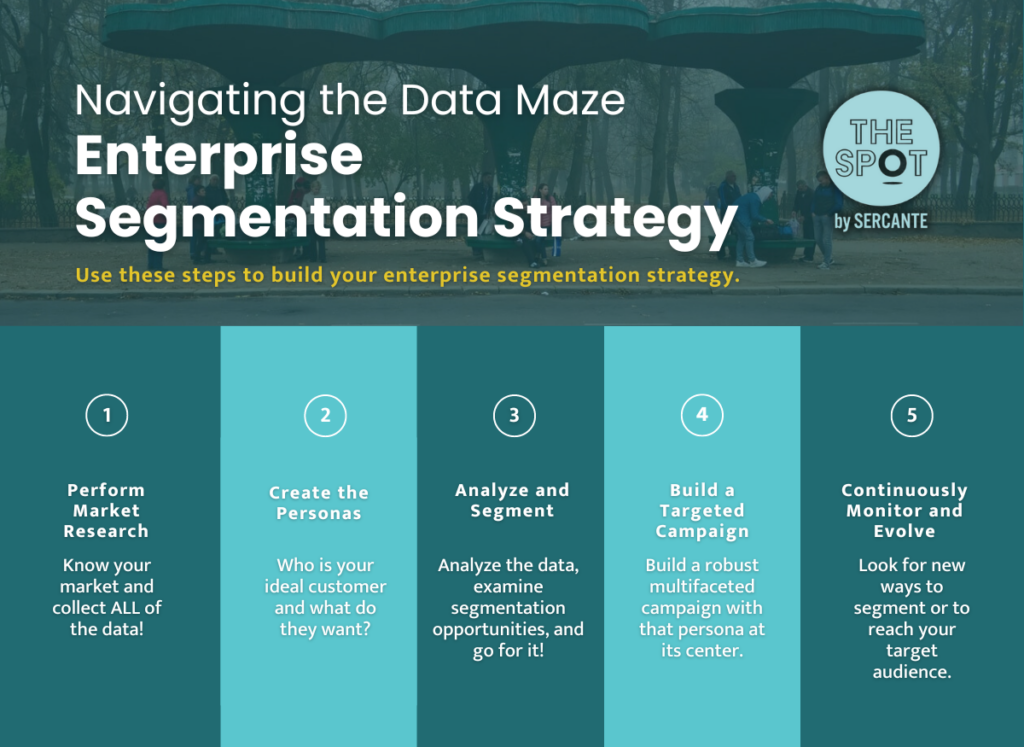In the age of big data, effective audience segmentation strategies are the key to unlocking the full potential of vast datasets available to enterprise-level companies. Join me on a journey from data overload to impactful insights as we explore how enterprise segmentation strategy drives meaningful results.
From demographic segmentation to behavioral analysis, we’ll delve into the various segmentation approaches that empower enterprise companies like yours to understand their audiences on a deeper level.
Segmentation strategies for enterprise marketers
Businesses today face a monumental challenge: how do they effectively harness and analyze the customer information that’s at their disposal?
One powerful solution is audience segmentation. By dividing large datasets into smaller, more manageable subsets based on common characteristics or behaviors, segmentation enables enterprises to unlock the hidden value within their data and make informed decisions that significantly impact their bottom line.
In this blog, we’ll examine the fundamental principles of segmentation, discuss its various applications, and provide practical insights into implementing segmentation strategies that deliver measurable results for marketers at enterprise companies.
Demystifying Segmentation
At its core, segmentation is a strategy marketers use to divide their broad customer base into smaller groups based on shared characteristics, behaviors, or preferences. The end goal is that marketing has specifically targeted lists to tailor their efforts. With their extensive reach and scale, enterprise businesses typically have large target audiences spanning across different demographics, geographies, and industries.
These audiences can encompass millions of consumers, making effective targeting and engagement a significant challenge. However, by having the marketing team segment its audience into smaller, more manageable groups, your business can tailor their marketing efforts, products, and services to meet customer needs.
Data Distilled
Identifying segmentation criteria determines the variables that will be used to divide target audiences into distinct segments. The choice of segmentation criteria depends on the specific goals of the business, the nature of the product or service being offered, and the available data.
Standard segmentation criteria include geographic, behavioral, product interest, or demographic factors. Businesses can create meaningful segments that enable more targeted and effective marketing strategies by carefully selecting segmentation criteria that are relevant, actionable, and aligned with business objectives.
Geography
Geographic segmentation focuses on location or region. This is most often used when there is great variation between consumers based on their locale.
One well-known enterprise to use this strategy is McDonald’s. In a recent article written by Two Teachers, they share that “By tailoring its products, services, and marketing messages to meet the unique preferences and needs of consumers in different regions, McDonald’s has been able to create a powerful global brand that resonates with people from all walks of life.”
McDonald’s successfully uses geographic segmentation daily by tailoring their advertising and their menu items, to fit the local preferences. For example, here in the United States, we may seek the Big Mac, whereas in Japan, their HiruMac Teriyaki McBurger. Yum!
Behavioral
Behavioral segmentation includes purchase history, loyalty, and social engagement. This strategy focuses on consumer preferences and patterns, and Netflix is one of many enterprises using this method daily.
According to Scientific American, “users discover around 80 percent of shows through algorithmic recommendations.” For Netflix, this is highly dependent on users sharing their ratings along with watching preferences and saves. With AI at our disposal, behavioral targeting is becoming even more popular and easier.
Psychological
Pscychographic segmentation prioritizes attitudes, values, lifestyles, and interests. This method targets a customer’s motivations and preferences. This is a broader method, as it can be challenging to target someone based on feelings, but some brands do it successfully.
Let’s take a look at Nike. According to PDF Agile, Nike has very specific personalities they are targeting – men who go to the gym and love sports, women who exercise or prefer sportswear, and children who are also athletes.
According to that article, “Nike focuses on the people who enjoy engaging in sports. The company is passionate about sports, and it makes products suitable for sports lovers.” As a result, all of their campaigns are focused on that type of individual.
Demographic
Demographic segmentation assesses age, gender, income, education, job role/title, etc. This strategy allows business to tailor their marketing efforts to meet the needs of a specific demographic. This is the easiest of the segmentation strategies as it is the easiest data to collect, and it’s also inexpensive while effective.
Let’s look into the financial sector, which offers “different tiers of products and services based on income levels,” according to Faster Capital. Affluent customers are targeted and sold premium credit cards with high fees and exclusive perks, while a college student would be offered a credit card with low fees and a rewards program.
Navigating the Data Maze: Enterprise Segmentation Strategy
So, how do I get from point A to point Z? Let me walk you through it.
- Perform Market Research: Know your market and collect ALL of the data!
- Create the Personas: Who is your ideal customer and what do they want?
- Analyze and Segment: Analyze the data, examine segmentation opportunities, and go for it!
- Build a Targeted Campaign: Build a robust multifaceted campaign with that persona at its center.
- Continuously Monitor and Evolve: Once you’re done, keep going. Be on the lookout for new ways to segment or reach your target audience in new and creative ways.

Get help with segmentation strategies for your enterprise team
Segmentation strategies are invaluable assets for enterprises seeking to navigate the complexities of modern markets and effectively engage with diverse customer bases.
Enterprises can gain deeper insights into customer preferences, behaviors, and needs by segmenting their audiences based on demographic, geographic, psychographic, and behavioral criteria. Moreover, the continuous refinement and optimization of segmentation strategies enable businesses to adapt to evolving market dynamics and stay ahead of competitors.
As enterprise companies continue to embrace the power of segmentation, they will unlock new opportunities for growth, innovation, and customer satisfaction.
We’ve helped countless enterprise teams figure out the best approach to audience segmentation, and would love to solve your segmentation challenges, too. Reach out the the team at Sercante to get help with your team’s segmentation strategies.








